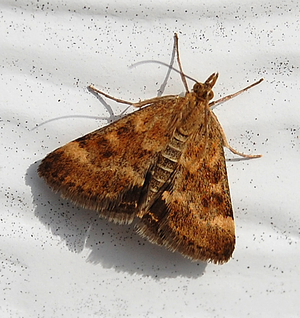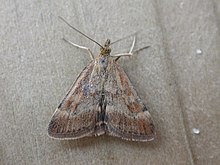Olive-brown moth
| Olive-brown moth | ||||||||||||
|---|---|---|---|---|---|---|---|---|---|---|---|---|

Olive-brown borer ( Pyrausta despicata ) |
||||||||||||
| Systematics | ||||||||||||
|
||||||||||||
| Scientific name | ||||||||||||
| Pyrausta despicata | ||||||||||||
| ( Scopoli , 1763) |
The olive-brown corn borer or olive brown corn borer ( Pyrausta despicata , Syn. : Pyrausta cespitalis ) is a butterfly from the family of Crambidae .
features
The moths reach a wingspan of 14 to 20 millimeters, or a fore wing length of 7 to 9 mm. The coloring and drawing of the forewings is very variable; it ranges from olive gray to blackish brown. There is a gender dichroism in which the males are mostly colored in a relatively monotonous manner, while the females are more contrasted by additional yellow and black drawing elements. Usually there are inner and outer transverse lines on the forewings; the two lines can be lighter or darker than the base color. Most of them have a corresponding light or dark border. The inner transverse line is wavy, the outer transverse line wavy to jagged. But there are also copies with very few drawings in which the transverse lines are almost completely absent. Many specimens have two well-developed, dark-edged blemishes in the middle, for example at the point of ring and kidney blemishes. Other specimens have one or two distinct arrow marks of different sizes in the middle field. The border area is often darker than the basic color. In the outer part, a zone of different widths can be brightened to a greater or lesser extent; in the extreme case a light-colored cross band is formed.
The hind wings have a blackish base color and have two bands, the color of which can vary from white to golden yellow. The outer band is usually much narrower than the median band and in some specimens can be reduced to a very narrow line. Older, flown moths can differ greatly in their coloring from newly hatched animals.
The caterpillars are light to dark brown-green in color and have weakly indicated, gray or yellowish back lines. The head and neck shield are brown. The pinacula are dark brown and usually outlined in light. The adult caterpillar is up to 16 mm long.
Geographical distribution and habitat
Pyrausta despicata is widespread and common in almost all of Europe. In the east, the distribution area extends over Siberia, the Russian Far East, northern China and the Korean peninsula to Japan. The southern border of the distribution runs through Asia Minor, the Caucasus region, Afghanistan and northern India. The species is also found in North America.
The species can be found from the plain up to an altitude of about 2,300 meters. It often occurs in dry, sandy or grassy places, its habitats include grasslands , alpine meadows, semi- arid grasslands and roadsides, to a lesser extent also swamp meadows and adjacent areas of fat and alpine meadows.
Way of life
Pyrausta despicata has two generations a year; the moths fly continuously from May to September. The moths are active at dusk and at night and come to artificial light sources. During the day, the animals rest hidden in the low herbaceous layer and can be scared off there easily. The females lay the eggs from at the leaf base of the larval food plants, these include plantain species like plantain ( Plantago major ), Hoary Plantain ( Plantago media ) and plantain ( Plantago lanceolata ). The caterpillars can be seen from June to July and from August to September. They often live gregariously in webs and initially feed on the underside of the leaf. At the beginning so-called window corrosion can be observed in later caterpillar stages also pitting and edge corrosion. The second generation caterpillars build a cocoon , overwinter and pupate in it in spring.
Systematics
The taxon was first scientifically described in 1763 by Giovanni Antonio Scopoli under the name Phalaena despicata . In the older literature, however, the species mostly appears under the younger synonym Pyrausta cespitalis (Denis & Schiffermüller, 1775). Another synonym is Pyralis sordalis Huebner, 1796.
swell
- ↑ a b Küppers (2008: p. 368)
- ↑ a b c Hannemann (1964: p. 360,362)
- ↑ Hasenfuss (1960: p.)
- ↑ Ayuna A. Shodotova: Pyralid Moths (Lepidoptera, Pyraloidea) of Buryatia: Family Pyraustidae. Entomological Review, 88 (5): 543-557, 2008 doi : 10.1134 / S0013873808050035
- ↑ a b Natural history information system. Marion and Michael Kurz and Christof Zeller, accessed July 17, 2009 .
- ↑ Slamka (1997: 22)
- ↑ Joannes Antonius Scopoli: Entomologia Carniolica: exhibens insecta Carnioliae indigena et distributa in ordines, genera, species, varietates: methodo linnaeana . 420 S., Vienna, Johannes Thomas Trattner, 1763 Online at biodiversitylibrary.org (description on page 231)
literature
- Karl Eckstein: The small butterflies of Germany. Stuttgart 1933.
- Hans-Joachim Hannemann: Small butterflies or Microlepidoptera II. The curlers (sl) (Cochylidae and Carposinidae). The moth-like (Pyraloidea). In: Friedrich Dahl: The animal world of Germany and the adjacent parts of the sea according to their characteristics and their way of life. Part 50, VEB Gustav Fischer Verlag Jena 1964
- Ivar Hasenfuss: The Larval systematics of the bulls (Pyralidae). 263 pp., Akademie-Verlag, Berlin 1960.
- Peter V. Küppers: Small butterflies. Recognize, determine. Fauna Verlag 2008, ISBN 978-3-935-980-24-1
- František Slamka: The common moth (Pyraloidea) of Central Europe: determination - distribution - flight area - way of life of the caterpillars . 2nd partially revised edition, Bratislava 1997, ISBN 80-967540-2-5
Web links
- Lepiforum e. V. (taxonomy and photos)
- Guide to the moths of Great Britain and Ireland. Ian Kimber, accessed August 3, 2011 .
- Moths and Butterflies of Europe and North Africa
- www.euroleps.ch - Heiner Ziegler's website
